tyre pressure MERCEDES-BENZ GLE SUV 2021 Owners Manual
[x] Cancel search | Manufacturer: MERCEDES-BENZ, Model Year: 2021, Model line: GLE SUV, Model: MERCEDES-BENZ GLE SUV 2021Pages: 545, PDF Size: 9.37 MB
Page 6 of 545
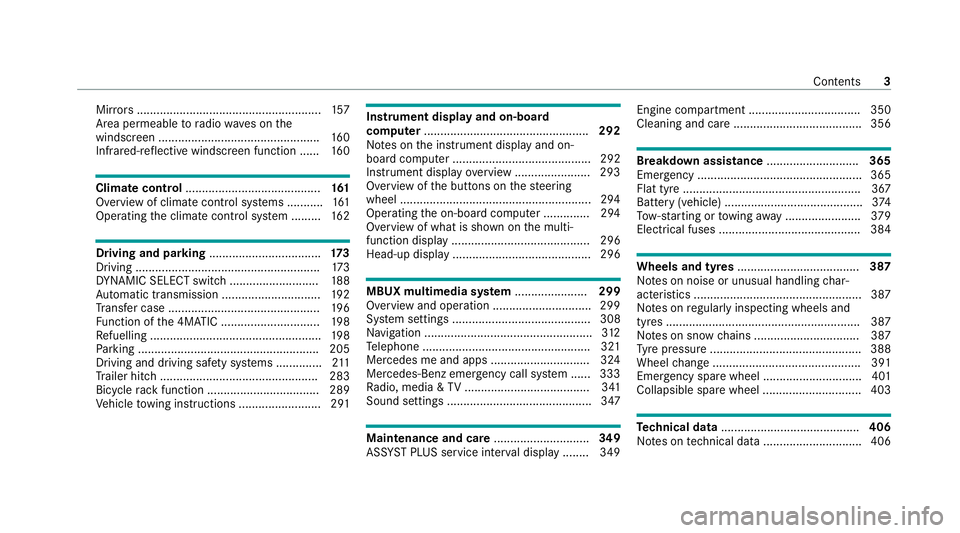
Mir
rors ........................................................ 157
Area pe rmeable toradio wav es on the
windscreen ................................................ .160
Infrared-reflective windscreen function ...... 16 0Climate control
......................................... 161
Overview of climate contro l systems ........... 161
Operating the climate control sy stem ......... 16 2 Driving and pa
rking .................................. 17 3
Driving ........................................................ 173
DY NA MIC SELECT switch ........................... 188
Au tomatic transmission .............................. 19 2
Tr ans fer case .............................................. 19 6
Fu nction of the 4MATIC .............................. 19 8
Re fuelling .................................................... 19 8
Pa rking ...................................................... .205
Driving and driving saf ety sy stems .............. 211
Tr ailer hit ch................................................ 283
Bicycle rack function .................................. 289
Ve hicle towing instructions ........................ .291 Instrument display and on-board
compu
ter.................................................. 292
No tes on the instrument display and on-
board computer .......................................... 292
Instrument display overview ...................... .293
Overview of the buttons on thesteering
wheel ..........................................................2 94
Operating the on-board computer .............. 294
Overview of what is shown on the multi‐
function display .......................................... 296
Head-up display .......................................... 296 MBUX multimedia sy
stem ...................... 299
Overview and operation .............................. 299
Sy stem settings .......................................... 308
Na vigation ................................................... 312
Te lephone .................................................. .321
Mercedes me and apps .............................. 324
Mercedes-Benz emer gency call sy stem ...... 333
Ra dio, media & TV...................................... 341
Sound settings ............................................ 347 Main
tenance and care ............................. 349
ASS YST PLUS service inter val display ........ 349 Engine compartment .................................. 350
Cleaning and care ......................................
.356 Breakdown assi
stance ............................ 365
Emergency ................................................. .365
Flat tyre ...................................................... 367
Battery (vehicle) .......................................... 374
To w- starting or towing away ....................... 379
Electrical fuses ........................................... 384 Wheels and tyres
..................................... 387
No tes on noise or unusual handling char‐
acteristics .................................................. .387
No tes on regular lyinspecting wheels and
tyres .......................................................... .387
No tes on snow chains ................................ 387
Ty re pressure .............................................. 388
Wheel change ............................................ .391
Emergency spare wheel .............................. 401
Collapsible spare wheel .............................. 403 Te
ch nical data .......................................... 406
No tes on tech nical da ta.............................. 406 Contents
3
Page 14 of 545
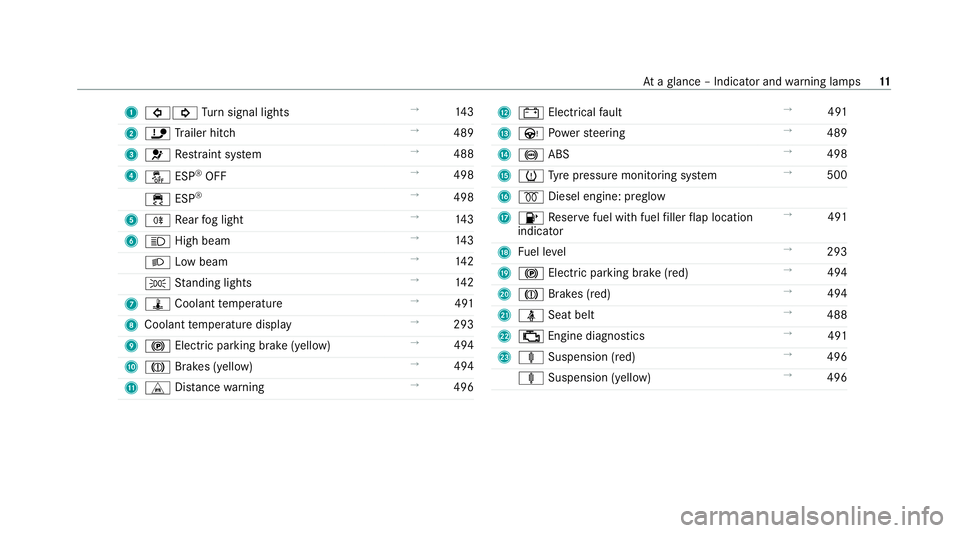
1
003E003D Turn signal lights →
14 3
2 ï Trailer hit ch →
489
3 0075 Restra int sy stem →
488
4 00BB ESP®
OFF →
498
00E5 ESP®
→
498
5 005E Rear fog light →
14 3
6 0057 High beam →
14 3
0058 Low beam →
14 2
0060 Standing lights →
14 2
7 ÿ Coolant temp erature →
491
8 Coolant temp erature display →
293
9 0024 Electric pa rking brake (yellow) →
494
A 004D Brakes (yellow) →
494
B L Distance warning →
496 C
003D Electrical fault →
491
D Ù Powe rst eering →
489
E 0025 ABS →
498
F 0077 Tyre pressure monitoring sy stem →
500
G 0028 Diesel engine: preglow
H 00B6 Reser vefuel with fuel filler flap location
indicator →
491
I Fuel le vel →
293
J 0024 Electric parking brake (red) →
494
K 004D Brakes (red) →
494
L 00E9 Seat belt →
488
M 00B9 Engine diagnostics →
491
N ä Suspension (red) →
496
ä Suspension (yell ow) →
496 At
aglance – Indicator and warning lamps 11
Page 22 of 545
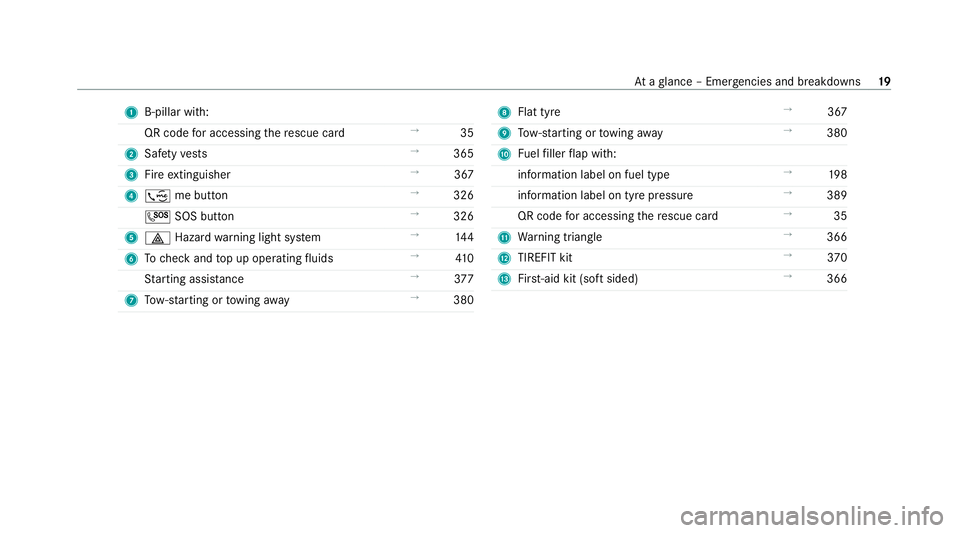
1
B-pillar with:
QR code for accessing there scue card →
35
2 Safetyve sts →
365
3 Fire extinguisher →
367
4 ; me button →
326
0053 SOS button →
326
5 002F Hazardwa rning light sy stem →
14 4
6 Tocheck and top up operating fluids →
41 0
St arting assis tance →
377
7 Tow- starting or towing away →
380 8
Flat tyre →
367
9 Tow- starting or towing away →
380
A Fuelfiller flap with:
information label on fuel type →
19 8
information label on tyre pressure →
389
QR code for accessing there scue card →
35
B Warning triangle →
366
C TIREFIT kit →
370
D First-aid kit (so ftsided) →
366 At
aglance – Emer gencies and breakdowns 19
Page 25 of 545
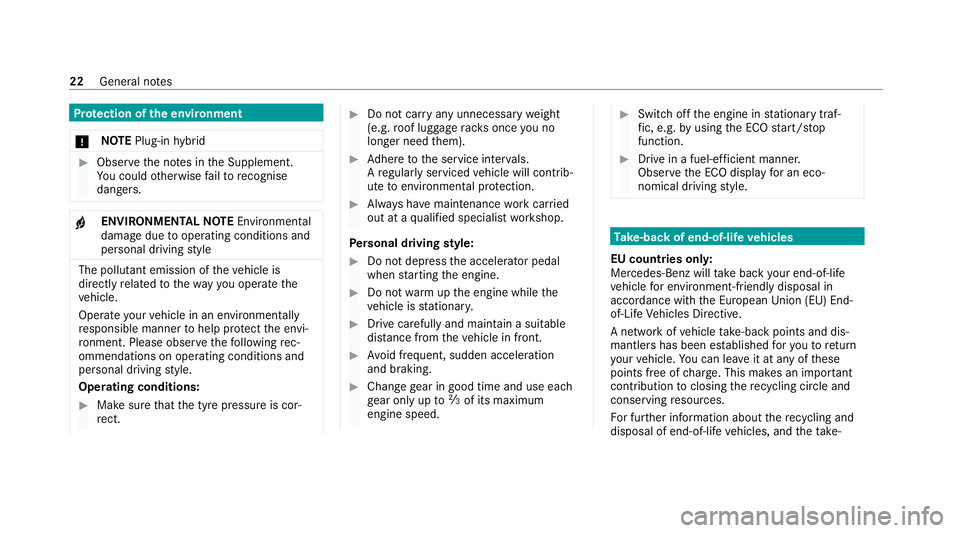
Pr
otection of the environment
* NO
TEPlug-in hybrid #
Obser vethe no tes in the Supplement.
Yo u could otherwise failto recognise
dangers. +
ENVI
RONMENTAL NOTEEnvironmental
dama gedue tooperating conditions and
personal driving style The pollutant emission of
theve hicle is
directly related tothewa yyo u operate the
ve hicle.
Operate your vehicle in an environmentally
re sponsible manner tohelp pr otect the envi‐
ro nment. Please obser vethefo llowing rec‐
ommendations on ope rating conditions and
pe rsonal driving style.
Operating conditions: #
Make sure that the tyre pressure is cor‐
re ct. #
Do not car ryany unnecessary weight
(e.g. roof luggage rack s once you no
lon ger need them). #
Adhere tothe service inter vals.
A regularly serviced vehicle will contri b‐
ute toenvironmen tal pr otection. #
Alw ays ha vemaintenance workcar ried
out at a qualified specialist workshop.
Pe rsonal driving style: #
Do not depress the accelera tor pedal
when starting the engine. #
Do not warm upthe engine while the
ve hicle is stationar y. #
Drive carefully and maintain a suitable
dist ance from theve hicle in front. #
Avoid frequent, sudden acceleration
and braking. #
Change gear in good time and use each
ge ar on lyup to00C3 of its maximum
engine speed. #
Switch off the engine in stationary traf‐
fi c, e.g. byusing the ECO start/ stop
function. #
Drive in a fuel-ef ficient manne r.
Obser vethe ECO display for an eco‐
nomical driving style. Ta
ke -back of end-of-life vehicles
EU countries onl y:
Mercedes-Benz will take back your end-of-life
ve hicle for environment-friendly disposal in
accordance with the European Union(EU) End-
of-Life Vehicles Directive.
A network of vehicle take -ba ckpoints and dis‐
mantlers has been es tablished foryo uto return
yo ur vehicle. You can lea veit at any of these
points free of charge . This makes an impor tant
contribution toclosing there cycling circle and
conse rving resources.
Fo r fur ther information about there cycling and
disposal of end-of-life vehicles, and theta ke- 22
General no tes
Page 31 of 545

Te
ch nology Frequency rang eT ransmission output/magnetic field
st re ngth
Near-field communication 13.553–13.567 MHz ≤ 42 dBμA/m at10 m
Con venience central lo cking sy stem, garage
door opener, tyre pressure monitoring sy stem 433 MHz (433.05–434.79 MHz)≤
10mW ERP
Heater boos ter function remo tecontrol, garage
door opener 868 MHz (868.0–868.6 MHz
)≤25 mW ERP
Heater boos ter function remo tecontrol, garage
door opener 869 MHz (868.7–869.2 MHz
)≤25 mW ERP
RLAN 5.1 GHz UNII-1 (5150–5250 MHz) ≤ 25 mW EIRP
Blue tooth ®
, Kleer, RLAN, remo tecontrol, wire‐
less headphones 2.4 GHz ISM band (2400–2483.5 MHz
)≤100 mW EIRP
Sensor for interior pr otection, RLAN 5.8 GHz UNII-3 (5725–58 75MHz) ≤ 25 mW EIRP
Con venience central lo cking sy stem 7.25 GHz UWB (6.0–8.5 GHz) ≤ -41.3 dBm/MHz EIRP mean ≤ 0 dBm/MHz
EIRP peak
76 GHz radar 76–77 GHz ≤ 55 dBm peak EIRP28
General no tes
Page 39 of 545
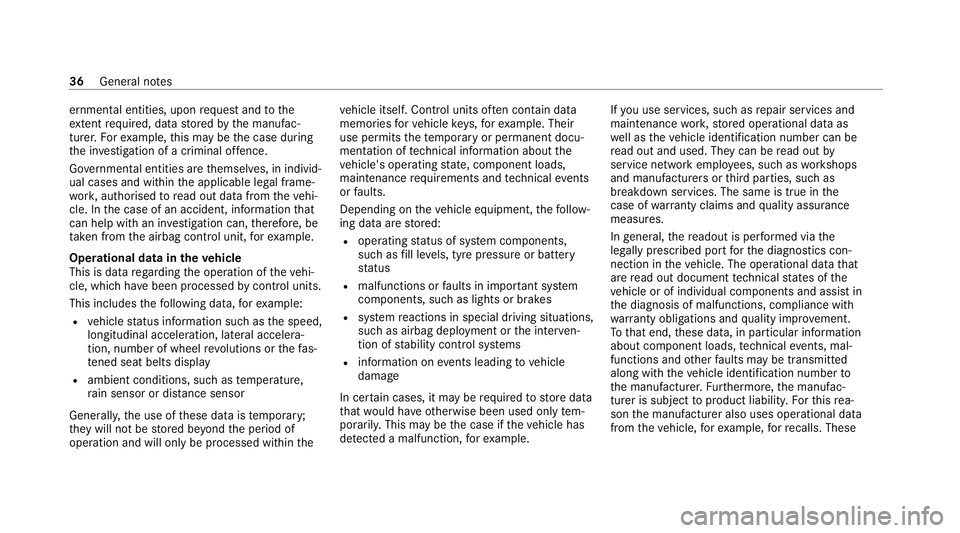
ernmen
tal entities, upon request and tothe
ex tent requ ired, data stored bythe manufac‐
turer. Forex ample, this may be the case during
th e in vestigation of a criminal of fence.
Go vernmental entities are themselves, in individ‐
ual cases and within the applicable legal frame‐
wo rk, authorised toread out data from theve hi‐
cle. In the case of an accident, information that
can help with an in vestigation can, therefore, be
ta ke n from the airbag control unit, forex ample.
Operational data in theve hicle
This is data rega rding the operation of theve hi‐
cle, which ha vebeen processed bycontrol units.
This includes thefo llowing data, forex ample:
R vehicle status information such as the speed,
longitudinal acceleration, lateral accelera‐
tion, number of wheel revo lutions or thefa s‐
te ned seat belts displ ay
R ambient conditions, such as temp erature,
ra in sensor or dis tance sensor
General ly,th e use of these data is temp orar y;
th ey will not be stored be yond the period of
operation and will only be processed within theve
hicle itself. Control units of ten contain da ta
memories forve hicle keys,fo rex ample. Their
use permits thete mp orary or permanent docu‐
mentation of tech nical information about the
ve hicle's operating state, component loads,
main tenance requ irements and tech nical events
or faults.
Depending on theve hicle equipment, thefo llow‐
ing data are stored:
R operating status of sy stem components,
such as fill le vels, tyre pressure or battery
st atus
R malfunctions or faults in impor tant sy stem
components, such as lights or brakes
R system reactions in special driving situations,
such as airbag deployment or the inter ven‐
tion of stability control sy stems
R information on events leading tovehicle
damage
In cer tain cases, it may be requiredtostore data
th at wo uld ha veotherwise been used only tem‐
porarily. This may be the case if theve hicle has
de tected a malfunction, forex ample. If
yo u use services, such as repair services and
maintenance work,st ored operational data as
we ll as theve hicle identification number can be
re ad out and used. They can be read out by
service network emplo yees, such as workshops
and manufacturers or third parties, such as
breakdown services. The same is true in the
case of warranty claims and quality assurance
measures.
In general, there adout is per form ed via the
legally prescribed port forth e diagnostics con‐
nection in theve hicle. The operational data that
are read out document tech nical states of the
ve hicle or of individual components and assist in
th e diagnosis of malfunctions, compliance with
wa rranty obligations and quality impr ovement.
To that end, these data, in particular information
about component loads, tech nical events, mal‐
functions and other faults may be transmit ted
along with theve hicle identification number to
th e manufacturer. Furthermore, the manufac‐
turer is subject toproduct liability. Forth is rea‐
son the manufacturer also uses operational data
from theve hicle, forex ample, forre calls. These 36
General no tes
Page 180 of 545
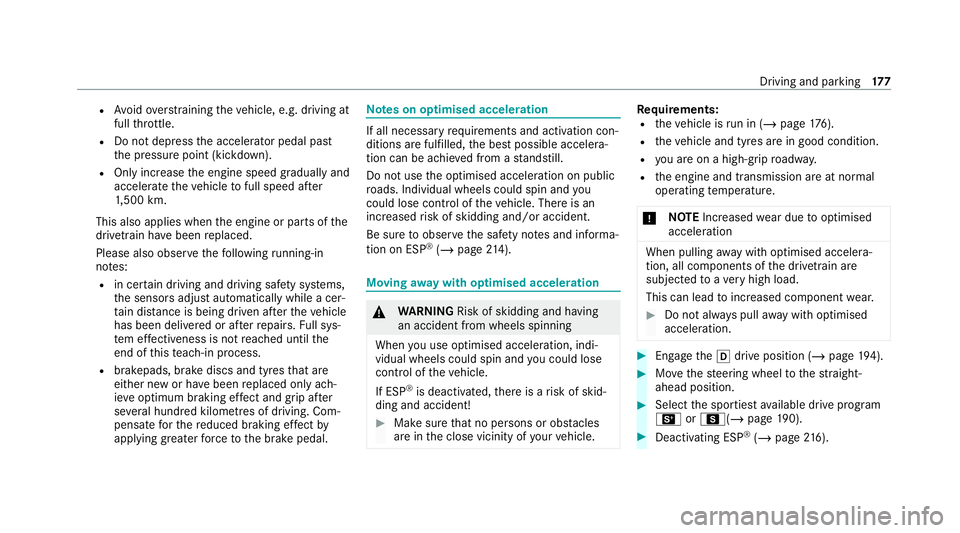
R
Avoid overstraining theve hicle, e.g. driving at
full thro ttle.
R Do not depress the accelerator pedal past
th e pressure point (kickdown).
R Only increase the engine speed gradually and
accelera tetheve hicle tofull speed af ter
1, 500 km.
This also applies when the engine or parts of the
driv etra in ha vebeen replaced.
Please also obser vethefo llowing running-in
no tes:
R in cer tain driving and driving saf ety sy stems,
th e sensors adjust automatically while a cer‐
ta in dis tance is being driven af terth eve hicle
has been delivered or af terre pairs. Full sys‐
te m ef fectiveness is not reached until the
end of this teach-in process.
R brakepads, brake discs and tyres that are
either new or ha vebeen replaced only ach‐
ie ve optimum braking ef fect and grip af ter
se veral hundred kilom etre s of driving. Com‐
pensate forth ere duced braking ef fect by
applying greaterfo rc eto the brake pedal. Note
s on optimised acceleration If all necessary
requ irements and activation con‐
ditions are fulfilled, the best possible accelera‐
tion can be achie ved from a standstill.
Do not use the optimised acceleration on public
ro ads. Individual wheels could spin and you
could lose control of theve hicle. There is an
increased risk of skidding and/or accident.
Be sure toobser vethe saf ety no tes and informa‐
tion on ESP ®
(/ page 214). Moving
away with optimised acceleration &
WARNING Risk of skidding and having
an accident from wheels spinning
When you use optimised acceleration, indi‐
vidual wheels could spin and you could lose
cont rol of theve hicle.
If ESP ®
is deactivated, there is a risk of skid‐
ding and accident! #
Make sure that no persons or obstacles
are in the close vicinity of your vehicle. Re
quirements:
R theve hicle is run in (/ page 176).
R theve hicle and tyres are in good condition.
R you are on a high-g rip ro adw ay.
R the engine and transmission are at normal
operating temp erature.
* NO
TEIncreased wear due tooptimised
acceleration When pulling
away with optimised accelera‐
tion, all components of the driv etra in are
subjected toave ry high load.
This can lead toinc reased component wear. #
Do not alw ays pull away with optimised
acceleration. #
Engage the005B drive position (/ page194). #
Movethesteering wheel tothest ra ight-
ahead position. #
Select the sportiest available drive program
B orC(/ page190). #
Deactivating ESP ®
(/ page 216). Driving and pa
rking 17 7
Page 204 of 545
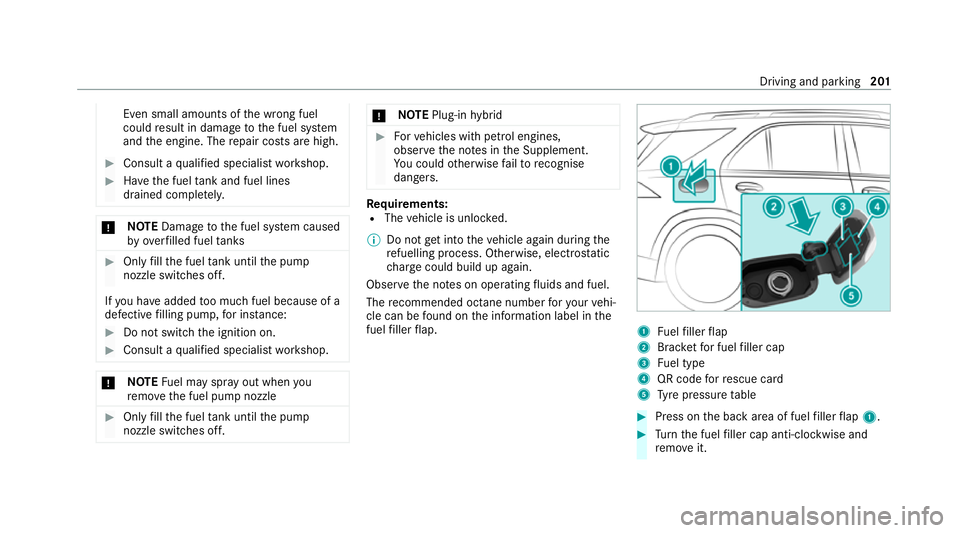
Even small amounts of
the wrong fuel
could result in damage tothe fuel sy stem
and the engine. The repair costs are high. #
Consult a qualified specialist workshop. #
Have the fuel tank and fuel lines
drained compl etely. *
NO
TEDama getothe fuel sy stem caused
by ove rfilled fuel tanks #
Only fill th e fuel tank until the pump
nozzle switches off.
If yo u ha veadded too much fuel because of a
defective filling pump, for ins tance: #
Do not switch the ignition on. #
Consult a qualified specialist workshop. *
NO
TEFuel may spr ayout when you
re mo vethe fuel pump nozzle #
Only fill th e fuel tank until the pump
nozzle switches off. *
NO
TEPlug-in hybrid #
Forve hicles with petrol engines,
obser vethe no tes in the Supplement.
Yo u could otherwise failto recognise
dangers. Re
quirements:
R The vehicle is unloc ked.
% Do not get into theve hicle again during the
re fuelling process. Otherwise, electros tatic
ch arge could build up again.
Obser vethe no tes on operating fluids and fuel.
The recommended octane number foryo ur vehi‐
cle can be found on the information label in the
fuel filler flap. 1
Fuelfiller flap
2 Brac ketfo r fuel filler cap
3 Fuel type
4 QR code forre scue card
5 Tyre pressure table #
Press on the back area of fuel filler flap 1. #
Turn the fuel filler cap anti-clockwise and
re mo veit. Driving and parking
201
Page 216 of 545
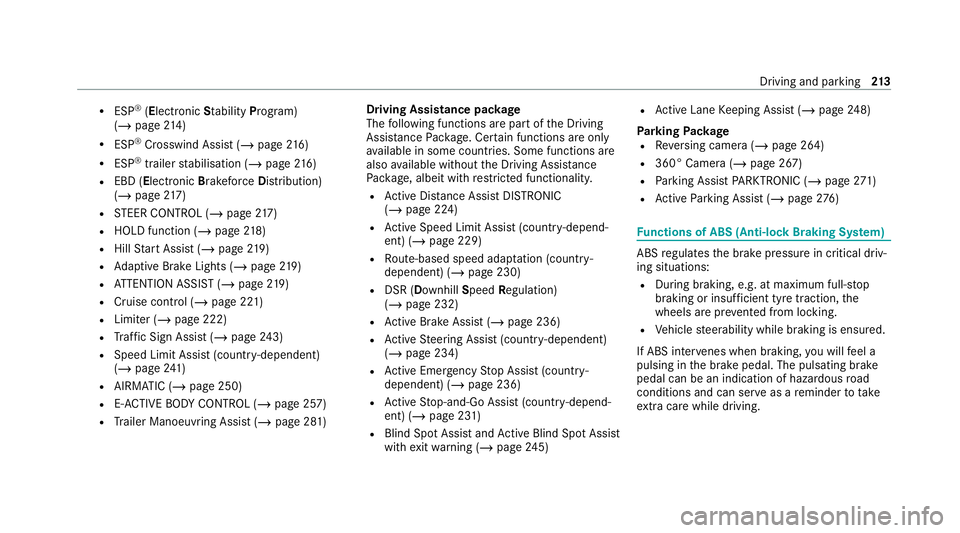
R
ESP ®
(E lectronic Stability Program)
(/ page 214)
R ESP ®
Crosswind Assist (/ page216)
R ESP ®
trailer stabilisation (/ page216)
R EBD ( Electronic Brakeforc eDistribution)
(/ page 217)
R STEER CONTROL (/ page 217)
R HOLD function (/ page218)
R Hill Start Assist (/ page219)
R Adaptive Brake Lights (/ page219)
R ATTENTION ASSIST (/ page219)
R Cruise control (/ page 221)
R Limi ter (/ page 222)
R Traf fic Sign Assi st (/ page 243)
R Speed Limit Assi st(countr y-dependent)
(/ page 241)
R AIRMATIC (/ page 250)
R E-AC TIVE BODY CONTROL (/ page 257)
R Trailer Manoeuv ring Assi st (/ page 281) Driving Assistance pac
kage
The following functions are part of the Driving
Assis tance Package. Cer tain functions are only
av ailable in some countries. Some functions are
also available without the Driving Assis tance
Pack age, albeit with restricted functionality.
R Active Dis tance Assi stDISTRONIC
(/ page 224)
R Active Speed Limit Assi st(countr y-depend‐
ent) (/ page 229)
R Route-based speed adap tation (countr y-
dependent) (/ page 230)
R DSR (Dow nhillSpeed Regulation)
(/ page 232)
R Active Brake Assi st (/ page 236)
R Active Steering Assist (count ry-dependent)
(/ page 234)
R Active Emergency Stop Assist (countr y-
dependent) (/ page 236)
R Active Stop-and-Go Assist (countr y-depend‐
ent) (/ page 231)
R Blind Spot Assist and Active Blind Spot Assi st
with exitwa rning (/ page245) R
Active Lane Keeping Assist (/ page248)
Park ingPackage
R Reversing camera (/ page 264)
R 360° Camera (/ page 267)
R Parking Assist PARKTRONIC ( /page 271)
R Active Parking Assist (/ page276) Fu
nctions of ABS (Anti-lock Braking Sy stem) ABS
regulates the brake pressure in critical driv‐
ing situations:
R During braking, e.g. at maximum full-s top
braking or insuf ficient tyre traction, the
wheels are pr evented from lock ing.
R Vehicle steerability while braking is ensured.
If ABS inter venes when braking, you will feel a
pulsing in the brake pedal. The pulsating brake
pedal can be an indication of hazardous road
conditions and can ser veas a reminder totake
ex tra care while driving. Driving and pa
rking 213
Page 225 of 545
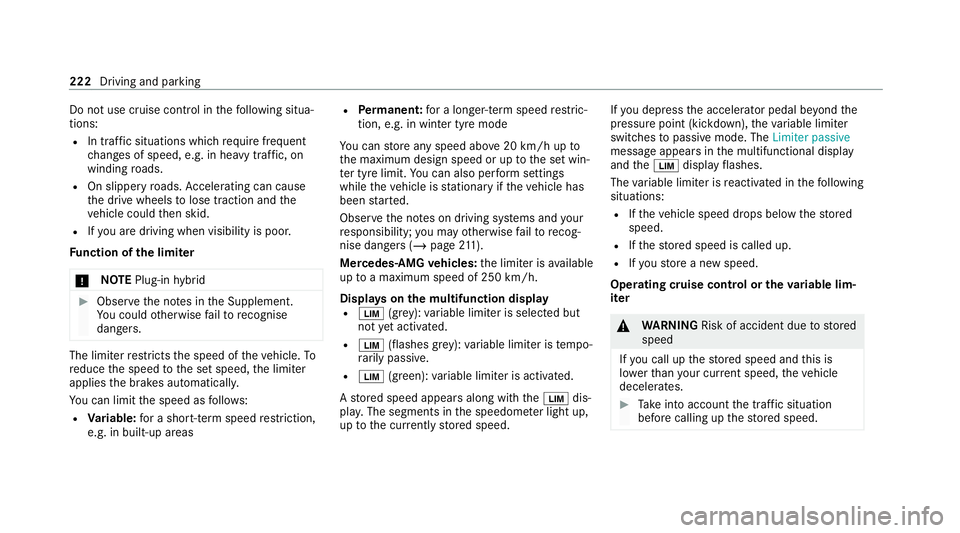
Do not use cruise control in
thefo llowing situa‐
tions:
R In traf fic situations whi chrequ ire frequent
ch anges of speed, e.g. in heavy traf fic, on
winding roads.
R On slippe ryroads. Accelerating can cause
th e drive wheels tolose traction and the
ve hicle could then skid.
R Ifyo u are driving when visibility is poor.
Fu nction of the limiter
* NO
TEPlug-in hybrid #
Obser vethe no tes in the Supplement.
Yo u could otherwise failto recognise
dangers. The limiter
restricts the speed of theve hicle. To
re duce the speed tothe set speed, the limiter
applies the brakes automaticall y.
Yo u can limit the speed as follo ws:
R Variable: for a short-term speed restriction,
e.g. in built-up areas R
Perm anen t:for a longer-term speed restric‐
tion, e.g. in winter tyre mode
Yo u can store any speed abo ve20 km/h up to
th e maximum design speed or up tothe set win‐
te r tyre limit. You can also per form settings
while theve hicle is stationary if theve hicle has
been star ted.
Obser vethe no tes on driving sy stems and your
re sponsibility; you may otherwise failto recog‐
nise dangers (/ page 211).
Mercedes‑AMG vehicles: the limiter is available
up toa maximum speed of 250 km/h.
Displ ays on the multifunction display
R 00CB (grey):va riable limiter is selec ted but
not yet acti vated.
R 00CB (flashes gr ey):va riable limiter is temp o‐
ra rily passive.
R 00CB (green): variable limiter is activated.
A stored speed appears along with the00CB dis‐
pla y.The segments in the speedome ter light up,
up tothe cur rently stored speed. If
yo u depress the accelerator pedal be yond the
pressure point (kickdown), theva riable limiter
swit ches topassive mode. The Limiter passive
message appears in the multifunctional display
and the00CB display flashes.
The variable limiter is reactivated in thefo llowing
situations:
R Ifth eve hicle speed drops below thestored
speed.
R Ifth estored speed is called up.
R Ifyo ustore a new speed.
Operating cruise control or theva riable lim‐
iter &
WARNING Risk of accident due tostored
speed
If yo u call up thestored speed and this is
lo we rth an your cur rent speed, theve hicle
decelerates. #
Take into account the tra ffic situation
before calling up thestored speed. 222
Driving and parking